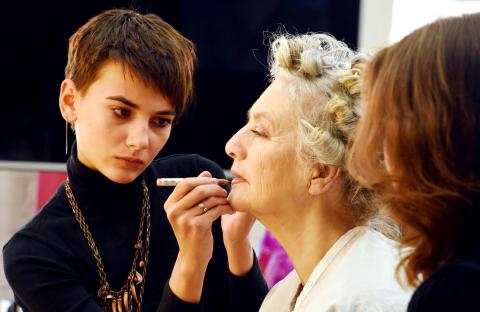In Russia, elderly women are usually expected to forget about fashion and watch their grandchildren. Not 71-year-old Olga Kondrasheva, who is fighting stereotypes by modeling for a glossy magazine.
“I’m over 70 now but my life is just beginning and it’s so interesting,” says Kondrasheva, slim and sporting wavy white hair, a few minutes before a studio photoshoot for the Russian edition of Cosmopolitan magazine in central Moscow.
With a lifelong zest for adventure, she used to take part in zoological expeditions to study wildlife across Russia and has worked as an extra in films. She admits she “never trained as a model,” but says she has “always been fascinated by this line of work.”

Photo: AFP
“I’m discovering a totally new side to myself. When I’ve had my hair and make-up done and I’ve got a nice outfit on and there’s some lovely music playing, it’s wonderful,” she enthuses.
Kondrasheva found herself posing for the cameras thanks to a Web site called Oldushka (“Oldie”) launched by photographer Igor Gavar.
“I wanted to show that older people can work in the fashion industry and they can be beautiful — even with wrinkles and white hair,” he says.
The site serves as an informal modeling agency by showcasing studio shots of Gavar’s elderly subjects, who like catwalk queens a quarter of their age have been spotted in all kinds of places — on the street, in a supermarket and even a dance floor.
Gavar has managed to organize numerous photoshoots for his dozen or so “muses,” including 80-year-old former air stewardess Irina Denisova and 64-year-old Lyudmila Brazhkina, a retired engineer.
Several striking silver-haired men are also on Oldushka’s books, though of those who have scored shoots in Russian fashion catalogs, magazines and advertisements so far, all but one have been women.
post-retirement income
The retirement age in Russia is 55 for women and 60 for men. Many continue working long afterwards out of economic necessity — and few look forward to retirement, knowing that years of money worries likely lie ahead.
The average pension in Russia is only around US$200 per month, but Oldushka allows its models to “earn a little bit extra,” Gavar says.
He and the model split the fees for any shoots secured through the Web site, which have so far ranged from US$40 to US$300.
They say the work gives women a new lease of life and a confidence boost at a time when their main role in Russian society as “babushkas” or grandmas is to provide large amounts of free childcare.
“It brightens up my life. Doing this is always so joyful, so positive,” says Brazhkina.
“And I enjoy being viewed in a different way during the photoshoots — not the way I see myself in the mirror. It’s like a little holiday!” she says, smiling.
elderly potential
Old age has been enjoying something of a moment in global fashion as feminists challenge traditional beauty standards and as the West comes to grips with an aging population.
Last year French label Celine chose 82-year-old author Joan Didion as its new face, while Dolce & Gabbana, American Apparel and Saint Laurent have all featured elderly models in recent campaigns.
Russia faces a similar demographic trend as developed Western countries, with nearly a quarter of the population currently over retirement age, a figure expected to rise to 27 percent by 2025 — 39.9 million people, according to the health ministry.
Eduard Karyukhin, head of the Dobroye Delo (“Good Deed”) organization that works with elderly people, says “the stereotype of a retired woman who stays at home and looks after the grandchildren is changing.”
“Elderly people have enormous potential,” Karyukhin said. “They just need help with organizing their leisure activities.”
The women involved in Oldushka said family members sometimes find it hard to understand their new pastime.
“My husband was very angry at first. He kept asking me: what are you doing this for?” said Kondrasheva.
“But then he saw this was making my life interesting with lots of activity and it was keeping me fit. And now he is supportive.”

The unexpected collapse of the recall campaigns is being viewed through many lenses, most of them skewed and self-absorbed. The international media unsurprisingly focuses on what they perceive as the message that Taiwanese voters were sending in the failure of the mass recall, especially to China, the US and to friendly Western nations. This made some sense prior to early last month. One of the main arguments used by recall campaigners for recalling Chinese Nationalist Party (KMT) lawmakers was that they were too pro-China, and by extension not to be trusted with defending the nation. Also by extension, that argument could be

Aug. 4 to Aug. 10 When Coca-Cola finally pushed its way into Taiwan’s market in 1968, it allegedly vowed to wipe out its major domestic rival Hey Song within five years. But Hey Song, which began as a manual operation in a family cow shed in 1925, had proven its resilience, surviving numerous setbacks — including the loss of autonomy and nearly all its assets due to the Japanese colonial government’s wartime economic policy. By the 1960s, Hey Song had risen to the top of Taiwan’s beverage industry. This success was driven not only by president Chang Wen-chi’s

Last week, on the heels of the recall election that turned out so badly for Taiwan, came the news that US President Donald Trump had blocked the transit of President William Lai (賴清德) through the US on his way to Latin America. A few days later the international media reported that in June a scheduled visit by Minister of National Defense Wellington Koo (顧立雄) for high level meetings was canceled by the US after China’s President Xi Jinping (習近平) asked Trump to curb US engagement with Taiwan during a June phone call. The cancellation of Lai’s transit was a gaudy

The centuries-old fiery Chinese spirit baijiu (白酒), long associated with business dinners, is being reshaped to appeal to younger generations as its makers adapt to changing times. Mostly distilled from sorghum, the clear but pungent liquor contains as much as 60 percent alcohol. It’s the usual choice for toasts of gan bei (乾杯), the Chinese expression for bottoms up, and raucous drinking games. “If you like to drink spirits and you’ve never had baijiu, it’s kind of like eating noodles but you’ve never had spaghetti,” said Jim Boyce, a Canadian writer and wine expert who founded World Baijiu Day a decade